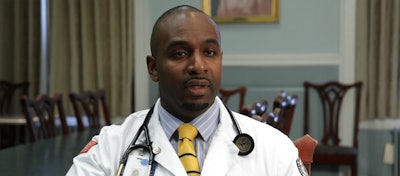While the United States continues to experience a shortage of Black physicians, part of the solution may come from abroad.
With its progressive standards for admission and the academic support available to its students, the American University of Antigua and its administrators believe the Caribbean institution is uniquely equipped to supply the country with highly trained physicians of color to ultimately enhance the patient experience.
“Culturally incompetent care is connected to poor patient outcomes and increased health disparities, regardless of quality service,” said Neal Simon, president of AUA. “In order to know what sets us apart, you have to know what’s going on in the medical profession.”
A 2017 study by the Association of American Medical Colleges, or AAMC, found that the number of Black males in medical schools has dropped since 1978 from 542 to 515 in 2014. AUA, however, matriculated over five times the national average for African-American males in 2015. For broader context, 13 percent of all students at American medical schools were underrepresented minorities in 2016. The same year, minority students made up 40 percent of AUA’s student body.
The MCAT is one explanation for the low national numbers. According to an AAMC report, experts in the field believe that the over-reliance on test scores for admission bars access for some talented students who may not be able to take the time off from working to study for the exam.
At AUA, Simon said, the admissions office does not dismiss an applicant for a low MCAT score.
 Dr. Eddie Copelin
Dr. Eddie Copelin“If someone provides us with a great MCAT score we would probably look at that like we look at anything else,” he said. He explained that all AUA students are required to take the MCAT either before or after enrollment because the institution needs to provide the U.S. Department of Education with test score data to qualify for federal funding. That said, a prospective student’s score can only strengthen the application. “We have a more holistic approach,” said Simon.
Jason Osei-Ameyaw, a second-year student at AUA, said he applied to the medical school because of an advertisement he saw on the website with an image of a young person working as a waiter. The accompanying text read something like “The opportunity to prove you’re not just a number.”
Osei-Ameyaw said he struggled as a pre-medical student at Baylor University during his first-year chemistry courses. Despite his later academic improvement, he was discouraged by advisors and peers. Osei-Ameyaw remembered one incident with a roommate whose father was a physician. Osei-Ameyaw asked the roommate if he could shadow his father, and the roommate said he would ask his father if he could find a Black doctor for Osei-Ameyaw to work with.
Although Osei-Ameyaw has never studied the AAMC data, he was not surprised to learn about the shortage of Black doctors. He reflected on the impact this scarcity has had on his own trajectory.
“My mother was sick in the hospital all the time. I never saw one Black doctor,” he said. Without these role models, Osei-Ameyaw’s motivation came from within. “You have to have faith in yourself if you don’t see it.”
Osei-Ameyaw sees AUA as a haven for diversity in the medical field. The administration supplements this institutional culture with its Education Department, or ED, which provides resources like one-on-one academic advising and peer mentorship. It also offers extra help for students who are repeating semesters.
“I don’t think we accept any student who cannot get through a program,” said Simon. “The ED program identifies students early who may be having problems.”
AUA also provides support for underrepresented students through two $50,000 scholarship programs, the Physician Diversity Initiative and the New York Minority Physician Award. Edwina Henry, an awardee for the Physician Diversification Initiative, said the scholarship was the determining factor for attending AUA.
Two past awardees of the Diversity Initiative have been valedictorians of AUA, and one, Dr. Jasmin Marcelin, went on to become the first resident at the prestigious Mayo Clinic from an international medical school.
In terms of outcomes, 96 percent of AUA students pass the Step 1, the first portion of the medical license examination. While international medical schools often carry negative reputations, AUA’s pass rate matches the average for all American medical schools.
“To get into Mayo Clinic, I had to score higher than people from U.S. medical schools, so there was no disadvantage there,” said Marcelin, who currently practices at University of Nebraska’s medical center.
Dr. Eddie Copelin, another alumnus, said that by addressing the shortage of Black males in medicine, AUA is helping target an even deeper cultural problem. Currently a physician at the Roger Williams Medical Center in Providence, Rhode Island, Copelin argued that not only are Black male doctors more likely to provide better overall treatment for Black patients, they can also provide mentorship for aspiring Black physicians, ending a self-perpetuating cycle for the profession.
“I feel as a Black male in medicine, you have to overcome negative stereotypes and also navigate a system where you’re a minority and maybe perceived as a threat when climbing the ladder in the industry,” he said. “Having a mentor is imperative.”
Joseph Hong can be reached at [email protected]





















